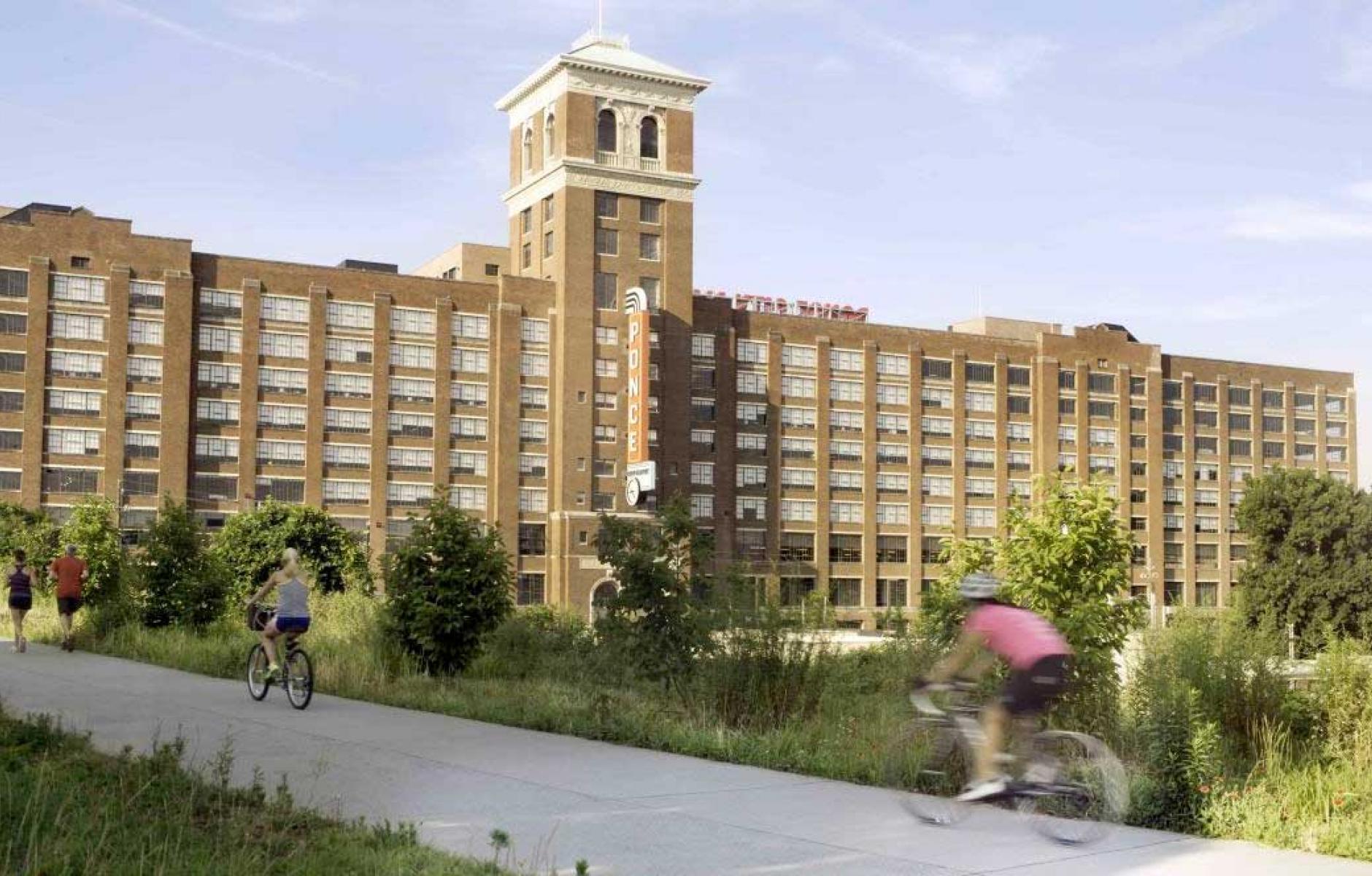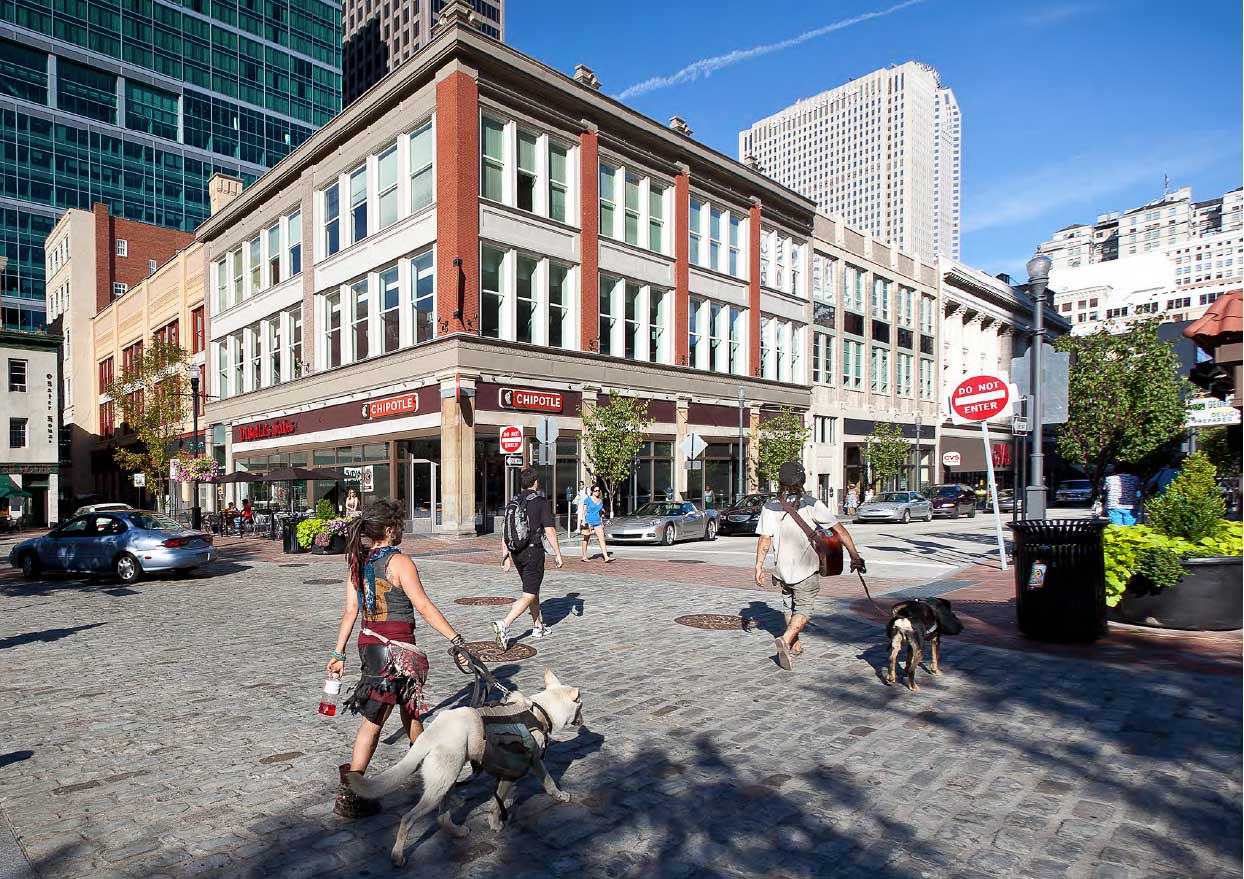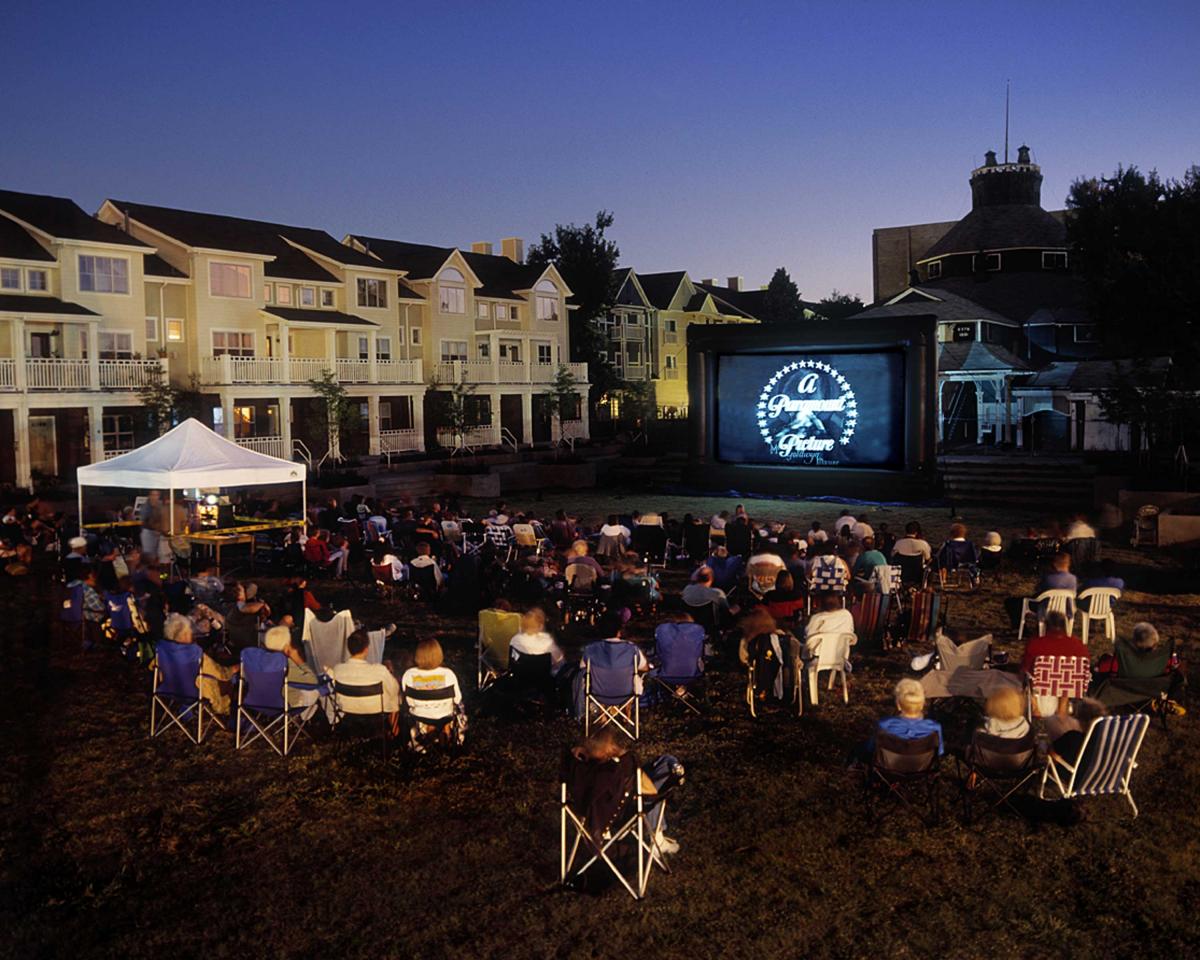
Preservation and urbanism go hand in hand
Note: This article is part of a collaboration between Island Press and Public Square on a series of articles based on recently published books on subjects related to urbanism.
A definitive book on the enormous impact of historic preservation on cities and towns in the last half century came out this month, written by Stephanie Meeks, president and CEO of the National Trust for Historic Preservation and coauthor Kevin C. Murphy.
The Past and Future City: How Historic Preservation is Reviving America’s Communities, connects historic preservation to the broader movement toward urbanism and the revival of cities and towns across America. Historic buildings are linked to walkability and have intrinsic economic and social value that appeals to millennials in particular.
The authors have the data to back up their claims in recent research conducted by the National Trust. They discuss how preservation can be integrated into new development, particularly new urbanist projects. Not every building can be preserved, but reuse ought to be the default option, Meeks says. She adds that urbanists and preservationists can pool their resources to craft the kinds of cities that are appealing to most Americans. Robert Steuteville, editor of Public Square, interviewed Meeks on the book and her ideas on preservation and urbanism.
What were your goals in writing the book?
My coauthor Kevin Murphy and I wrote the book with a group of people in mind in the US, mostly in city leadership—mayors, council, and commissions—who are responsible for the majority of the historic buildings in this country, and who may have little or no background at all in historic preservation. If you, as a mayor or council member, were to read one book on historic resources in your community and how to use these buildings as an asset, the goal was to make this be that book. Another goal was to bring together the best thinking in this field at this time.
I have run into many people in leadership positions who think of historic buildings as a problem rather than the opportunity. In this book, we wanted to illustrate the opportunity.
Why do people think that historic buildings are a problem?
We are a country that often thinks of just tearing things down and replacing with new. That’s sort of a disposable mentality. Reusing buildings well can be a complex undertaking, especially if you have never done it before, which is why we wanted to establish a primer on how to think about it. And a lot of people think of historic preservation as really expensive. We wanted to demonstrate that historic buildings are an economic driver for women and minority owned businesses and small businesses. They can bring different parts of the community together. And I know from my conversations with developers that if someone is thoughtful about using tax credits and other incentives that are available for historic buildings, it is no more expensive to restore a historic building than it is to build anew.
One thing that really struck me is how much of an impact historic preservation had on cities. As you were writing this book, once you laid it all out, were you surprised at the huge impact of historic preservation over the last 50 years?
What you find when you write a book like this and talk to people like you is that there is really a lot of support for preservation. We knew that from our market research, which tells us that there are something like 15 million people in the US today who are engaged in preservation in some way. That involvement may be living in a historic home and fixing it up all the way to being a professional preservationist. But there is nothing like having a book like this to talk to people about it and put a face to that statistic. We know that a lot of people care about what we do and are engaged in what we do. At the same time, we know that preservation has only made a bit of a difference. We talk about moving beyond the 5 percent solution. As we look at cities across the country, less than 5 percent of areas have a formal historic designation. When you look at it from that perspective, we need new tools and new approaches to get to a level where we make an even more meaningful impact.
It is clear that you think that historic preservation and urbanism are deeply intertwined. Can you talk a little bit about that?
In the book we start with an economic argument that is based on research by a division of the National Trust that is called The Preservation Green Lab. We released a report almost two years ago that was entitled Older, Smaller, Better, which mapped all the buildings in three cities: the District of Columbia, San Francisco, and Seattle, and looked at relative performance of 200 by 200 meter grid squares, to get an apples-to-apples comparison on 40 different metrics, including independent businesses, women-owned and minority owned businesses, density, activities on weekends and nights, Walk Score, etcetera. We found across this broad array of metrics, based on data that was not available to Jane Jacobs when she surmised a lot of these same observations, that again and again the blocks that had a mixture of old and new buildings performed better than those with new buildings alone. It underscored for us that there is clearly a role that historic buildings play in creating the kind of character and economic vitality that is making those blocks perform well, and that is really the central thesis of this book.

We are expanding that work, because those cities tend to be places that are pretty healthy economically and we wanted to test that methodology and our hypothesis in a broad array of cities—including so-called “cold market” cities and smaller cities—to see if the same things held true. We are releasing this study in November in what is called an “atlas of ReUrbanism” that will look at 50 cities using the same metrics. I haven’t seen the results but I have been told that a lot of the same themes are emerging in this broader study.
So on several different dimensions we could say that historic buildings are important to the broader topic of urbanism.
You talk quite a bit about Jane Jacobs, who is a founding figure in the urbanism and historic preservation movements. And you mention new urbanist Jeff Speck’s book Walkable City. Can you tell me why historic preservation is important to walkability, and whether the reverse true—is walkability important to preservation?
We find that, and this is an amplification of what Congress for the New Urbanism has been saying for some time, that there is an inherent humanity to the way our cities were designed before we had cars. To have the smaller scale buildings in human scale places that can accommodate all of the needs of life in a few blocks: We see that in historic districts, in parts of cities that have concentrations of historic buildings. The research shows that these districts are punching above their weight class in the number of small businesses and they are able to accommodate people across the economic spectrum. We also know that today, the largest generation in the history of the US, the millennials, are graduating from college and moving back into cities. Those people are attracted to the character and authenticity of historic buildings. As a demographic they are not as interested in owning cars. For some it is philosophical, for some it is an economic issue. They find these historic communities very attractive because of their density. They are able to live and work and play in a tighter area.

Do you think that urbanists and historic preservationists are sometimes at odds?
We haven’t found ourselves to be at odds. We find that we have a lot of common cause with urbanists. There is an opportunity for the National Trust and urbanists to be more engaged and to talk more about some of the ideas that we write about in The Past and Future City. But no, I don’t think we are at odds at all and we want to build more bridges with the CNU and like-minded organizations.
Do you think urbanists have learned the importance of historic preservation over the years? Do you think they could learn more about it?
Framing preservation in an urbanism way has only come recently, so I’d say the onus is on the preservation community to make its case—and I’d hope the book helps to do that. But I think we have a lot of common cause with the urbanist movement and we want to get more of these ideas in front of urbanists—because I think it will take every one of us to craft the kind of cities that we all want for ourselves.
You talk quite a bit about some new urbanist projects in the book, one is Highland Gardens Village, which is an interesting example. It’s a new neighborhood built in Denver on an infill site. It was a historic amusement park and they did some preservation on the site—including an old theater, and a carousel. It really adds to the character of what they built there. What makes for a successful new urbanist project with historic preservation?
That’s a great question. What we know is that millennials want that authenticity. They want where they live to be distinctive. I’m all for sensitive infill. In a lot of cities we have an affordability crisis and we don’t have enough housing units. Too often the response is “let’s tear down these small historic buildings and build towers.” What we would like to propose instead is that you restore the historic buildings along the lines of what you were saying, and instead do infill development where there are parking lots and other places where there are opportunities. That will achieve the density we need and address the affordability issues we face today.

Another thing you mention is that increasing age makes a building lovable and there seems to be some truth in that statement. Penn Station in Manhattan was 50 years old when they first started talking about tearing it down—It was a magnificent building and tearing it down helped launch the preservation movement. At the same time there are 1960s shopping malls that are abandoned, also 50 years old, and they are not all that lovable. How do you negotiate the reality that some buildings are more lovable than others, and some buildings need to be torn down?
We would like the default response to consider reuse rather than having demolition being the default response. There’s a strong environmental case to be made for thinking about recycling our buildings rather than tearing them down. If for no other reason than that one—that is a good policy for consideration. But I fully recognize, and the National Trust fully recognizes, that not every building is going to be protected and saved. There are guidelines for thinking about what buildings have national or state significance, and for every community to decide what adds value to their community. But it is true that we find that the older something is the more it is loved. It sometimes takes two generations for people to think something has charm.
Do you think it is just a matter time, if you give an abandoned Walmart 200 or 300 years, it will be lovable?
[Laughs] I’m not sure that the lovability in truth will extend to an abandoned Walmart store, you might have me there.
I love the section where you are talking about playgrounds and handball courts and you argue for a broader definition of historic preservation. My daughter who is 16 wants to preserve the playground in our neighborhood—it was a community built playground and it hasn’t been that well maintained by the school district. The playground is as old as she is, and it is hand built. It didn’t come out of a factory. Can you talk about why you argue for a broader definition of historic preservation and why it is important?
We argue for a broader definition in part because, as we address in the book, there has been a significant gap in the recognition of non-caucasians and women in historic preservation. We talk about diversity in preservation and it is a significant issue. What we see, though, is when we start engaging minority communities is that a lot of the built environment that may have been important to their story has been destroyed. So there aren’t as many buildings to protect. That’s why the Maravilla Handball Court (in a Latino Los Angeles neighborhood) is important, because that is a place that is important to that community. The other reason to expand the definition is that I am in the business of getting more people to embrace preservation. And that doesn’t just mean grand buildings. It can mean the playground at the end of the block. We want people to be empowered to think about their individual contributions to preservation in their own communities.

If you can talk about one important message that you would give to planners and urbanists, what would that be?
I’d say that historic buildings are a remarkable resource for achieving the kind of goals that cities are trying to achieve today in terms of economic development, affordability, building community cohesion, and addressing climate and environmental sustainability goals. There are cities all over the country that are finding ways to reuse those buildings to achieve many of those objectives. This book was written to help city leaders take advantage of that historic opportunity.




